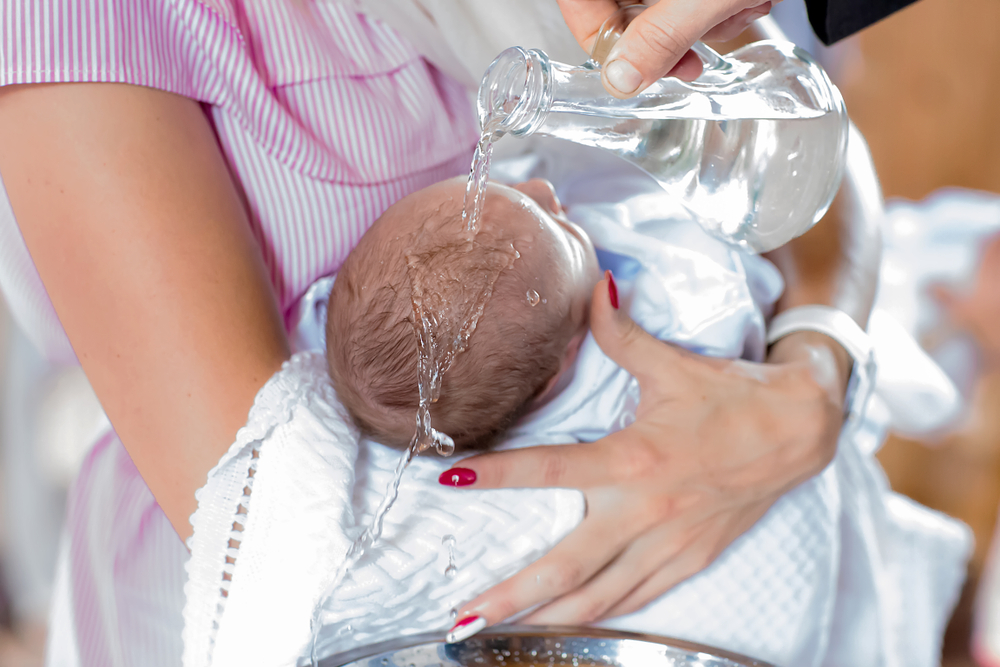You probably make a big deal out of your kids’ birthdays, so why not celebrate their baptism anniversaries, too? After all, baptism is “spiritual birth” into God’s family, giving your child a new identity, special powers and responsibilities, and a life mission. When it’s fully realized, baptism is a completely life-changing event.
The challenge, of course, is to fully realize the grace of baptism. And when it comes to infants and children, it’s the parents* who have the first responsibility for pulling that off, with the help of the faith community. Celebrating the anniversary of your kids’ baptisms is one way to emphasize its importance and teach them what it means.
A baptism anniversary celebration
Here are some of the materials you might want to gather for your celebration. All of these are optional:
- your child’s baptismal candle
- your child’s baptismal gown
- your child’s baptismal certificate
- photos or video of your child’s baptism
- holy water
- a white cloth or table runner
- fabric markers
- special foods and decorations for a party
With your child, mark his baptism anniversary date on your family calendar so that he’ll have something to look forward to, and briefly talk about why you’ll be having a special celebration.
On the big day, try one or more of the following ideas:
- Tell the story of your child’s baptism. You can do this over a meal or during your family prayer time. Pull out photos and/or video of the big day to help tell the story. Walk through the basic elements of the baptism (“First, the priest/deacon asked what name we wanted to give you, and we said ___,” etc.), including any interesting or funny details.
- Explain the significance of the baptism. Explain to your child that her baptism was like a “second birth.” Like her biological birth, it involved water. And just as her biological birth made her a part of your family, baptism made her a child of God through the power of the Holy Spirit. As a child of God, she gained many “brothers and sisters” who were also made children of God through baptism, and she became a member of the family called the Church. Finally, in baptism she was given responsibility for participating in Christ’s saving mission in the world, as well as the priestly, prophetic, and kingly authority to carry out that mission. See the Talking Points section below for more background. Obviously, you’ll need to adapt this explanation for the age and ability of your child.
- Display items from his baptism on your prayer table. Set out items from your child’s baptism on your prayer table or home oratory, if you have one. Include his baptismal gown and candle, if you kept them, as well as his baptismal certificate and photos.
- Light her baptismal candle during family prayer. If you kept her baptismal candle, light it during family prayer.
- Bless your child. Loyola Press offers this short family prayer service for a baptism anniversary, and Laura Kelly Fanucci at Mothering Spirit has written a beautiful blessing for the anniversary of a baptism. Otherwise, simply use holy water to bless your child’s forehead with the sign of the cross, praying words of your choosing under the inspiration of the Holy Spirit.
- Make a prayer cloth remembering your child’s baptism. Using fabric markers, decorate a small white tablecloth or table runner (or a large handkerchief) with your child’s name, baptism date, and other symbols of baptism, such as water, a dove, a candle, etc, as well as words or phrases about your child’s baptismal identity. Set this out on your table or home oratory during the week of your child’s baptism.
- Tell the story of the saint or person(s) your child is named for. Is your child named after a saint or a friend or relative? Tell him the significance of the name you chose for him.
- Let her choose a special food for the day. If choosing a special food is part of your birthday celebration routine, do the same on your child’s baptismal day. Children might also be interested in making decorations for the occasion. Challenge your child to come up with ideas for decorations that reflect the baptism theme.
- Play act a baptism. If your younger children are interested, play act “baptizing” a favorite doll or stuffed animal. You can use the Rite of Baptism as a guide, but it’s probably enough to teach younger children the essence of the rite—saying, “I baptize you in the name of the Father, and of the Son, and of the Holy Spirit” while immersing the person in water or pouring water over the person three times, once after the name of each person of the Trinity (Catechism #1278). Just as when you’re play acting “Mass,” you might want to explain that what you’re doing is pretend. Fun fact: While only an ordained minister can validly baptize under normal circumstances, lay people may perform a baptism when someone who wants to be baptized is in imminent danger of death and an ordained minister is not available (Catechism #1256).
Other ways to highlight your child’s baptism
To highlight the importance of your child’s baptism all year long, display a photo of the baptism in his or her room, or frame the baptismal certificate and display it on a wall.
If you’re a little more ambitious, create a work of art about your child’s baptism that emphasizes his or her new character in the grace of the sacrament, using phrases like “child of God,” “priest, prophet, king,” “on a mission for Christ,” etc. Some ideas:
- Using air dry clay, have your child make handprints in a disc of clay, then etch and/or paint his name underneath with the date of his baptism.
- Using glass paints, decorate a wide glass bowl with the name of your child and the date of her baptism, plus any other words or symbols that seem appropriate. On special occasions, put the bowl out on your prayer table with holy water in it.
Talking points: More about baptism
When celebrating the baptismal anniversary of older kids, take the opportunity to explain the meaning and significance of the sacrament to them. The following is not meant to be a comprehensive explanation of the sacrament; for that, see the Catechism of the Catholic Church or see Loyola Press’s The Sacrament of Baptism and What Happens at Baptism?
Here are some talking points to help:
- Baptism is the gateway to the sacramental life: It makes us children of God, members of the Body of Christ, and members of the Church. Baptism is the basis of the whole Christian life (Catechism #1213).
- By the grace of baptism, all our sins are forgiven—both personal sins and original sin (Catechism #1263, 1264). Of course, infants are not capable of committing personal sins, but even infants are marked by original sin. Original sin is what we call the wounded human nature that was passed on to all human beings by the sin of our first parents, Adam and Eve (Catechism #417).
- Baptism gives us a new identity, making us children of God, a member of Christ’s body and a sharer in his divine nature, and the Temple of the Holy Spirit (Catechism #1265).
- Baptism gives us the power to believe in God, to act under the prompting of the Holy Spirit, and the ability to grow in goodness through the moral virtues (Catechism #1266).
- Baptism makes us members of the Body of Christ, and therefore members of the Church. As members of Christ, we share in his priestly, prophetic, and royal mission (Catechism #1268).
- Baptism gives us rights and responsibilities within the Church—the responsibility to carry on the mission of Christ in the world, and the right to receive the spiritual help of the Church (Catechism #1269).
- In baptism, we are forever marked as belonging to Christ; nothing, not even our own sin, can remove this mark (Catechism #1272).
* Right at the beginning of the Rite of Baptism, the priest says to the parents: “You have asked to have your child baptized. In doing so you are accepting the responsibility of training him (her) in the practice of the faith. It will be your duty to bring him (her) up to keep God’s commandments as Christ taught us, by loving God and our neighbor. Do you clearly understand what you are undertaking?” The parents are instructed to say, “We do,” although in retrospect, most of us probably didn’t fully understand the enormity of that responsibility.



